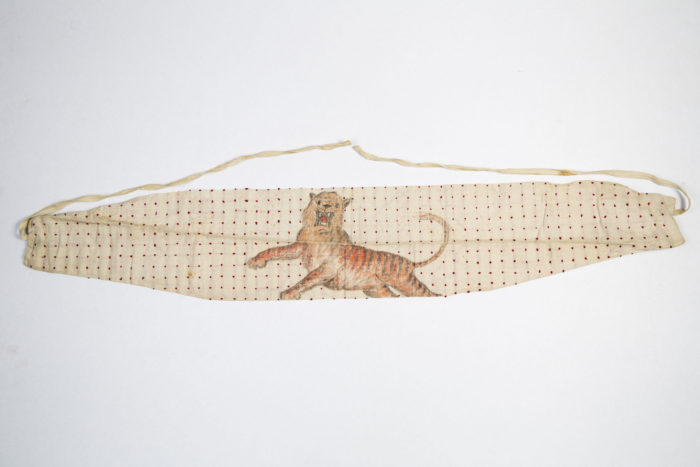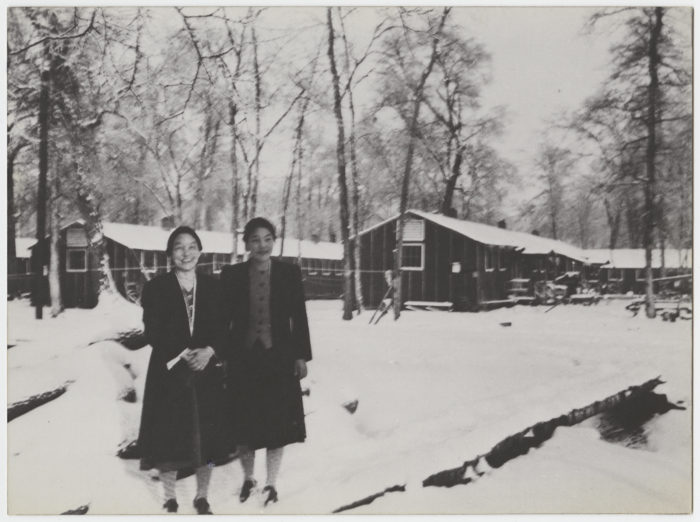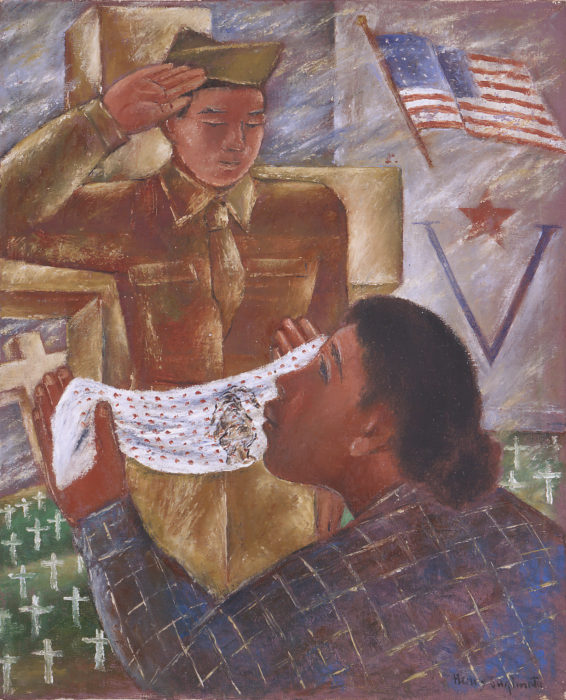A Soldier’s Treasure

Japanese American National Museum, Gift of Susumu Ito (94.306.2)
Click to open full-size image in new tab.This object is called a senninbari.
- How would you describe the senninbari?
- What materials is it made of?
- Why do you think there is a tiger depicted on it?
- What else do you notice?
- What might it have been used for?

Japanese American National Museum, Gift of Susumu Ito (94.306)
Click to open full-size image in new tab.Born in California in 1919 to a family of immigrant tenant farmers, Sus Ito was drafted into the US Army in February 1941. After the bombing of Pearl Harbor, he was switched to civilian duty while his family was sent to live at Rohwer concentration camp in Arkansas. In the spring of 1943, he was selected to join the 442nd Regimental Combat Team (RCT), 522nd Field Artillery Battalion. Ito went on to serve in all of the 442nd’s campaigns in Italy, France, and Germany, eventually rising to the rank of lieutenant. His tour of duty included high-profile historical events such as the rescue of the Lost Battalion and the liberation of a subcamp of Dachau.
During his time in Europe, Ito kept three things with him: a small Bible, a senninbari (Japanese 1000-stitch cloth belt traditionally given to soldiers who are going to war) made by his mother at Rohwer, and a 35mm Agfa camera. He took thousands of photographs documenting his life in the military and went to great lengths to preserve the negatives, even having some of them developed at villages he was stationed at along the way. Ito’s vast archive of images taken while on duty during World War II gives a rare and breathtaking look at daily life within the 522nd Field Artillery Battalion of the celebrated all-Japanese American 442nd RCT.
Susumu Ito video interview (July 8, 2015), Japanese American National Museum
Click to open full-size image in new tab.In this video clip, Dr. Ito says he didn’t wear his senninbari or show it to his fellow soldiers.
- Why do you think this is?

Henry Sugimoto, Untitled (In Camp Jerome), 1943, oil on canvas, Japanese American National Museum, Gift of Madeleine Sugimoto and Naomi Tagawa (92.97.9)
Click to open full-size image in new tab.This painting shows a senninbari as depicted by artist Henry Sugimoto.
- Who might the person holding the senninbari be?
- Who might the other individual in the image be?
- What symbols are evident in this image?

Japanese American National Museum, Gift of Susumu Ito (94.306.2)
Click to open full-size image in new tab.A senninbari (Japanese for “1000-person stitches”) is a strip of white cloth with 1000 red stitches, each made by a different woman, which is given to soldiers going off to war. It originated in Imperial Japan and served as an amulet for a safe return home.
Senninbaris are often made by mothers or wives, with a community of other women, to give protection to husbands and sons departing for war. Dr. Ito’s mother organized the women in Rohwer to contribute by each putting in a stitch; his cousin Emiko put the last stitch into this senninbari.
I so highly valued the senninbari that it was the item that bound me to my mother and furthermore made me feel that I had no fear that I might not survive the many combat experiences and come home intact. However, being an item that Japanese soldiers carried into combat, I did not tell anyone, even my closest buddy, that I had this item and kept it a secret through the War.
I treasured it. My mother used to tell me about senninbaris as a child. She sent it to me. I carried it in my pocket. I had a close attachment to it, and to my mother because she made it. I’d like to think that my senninbari helped get me back safely.
—Sus Ito, email to Lily Anne Yumi Welty Tamai, February 20, 2015
- How does the story of Dr. Ito’s senninbari reflect his identity as a Japanese American soldier and the anxiety of being Japanese American at that time?
Return to Identity
